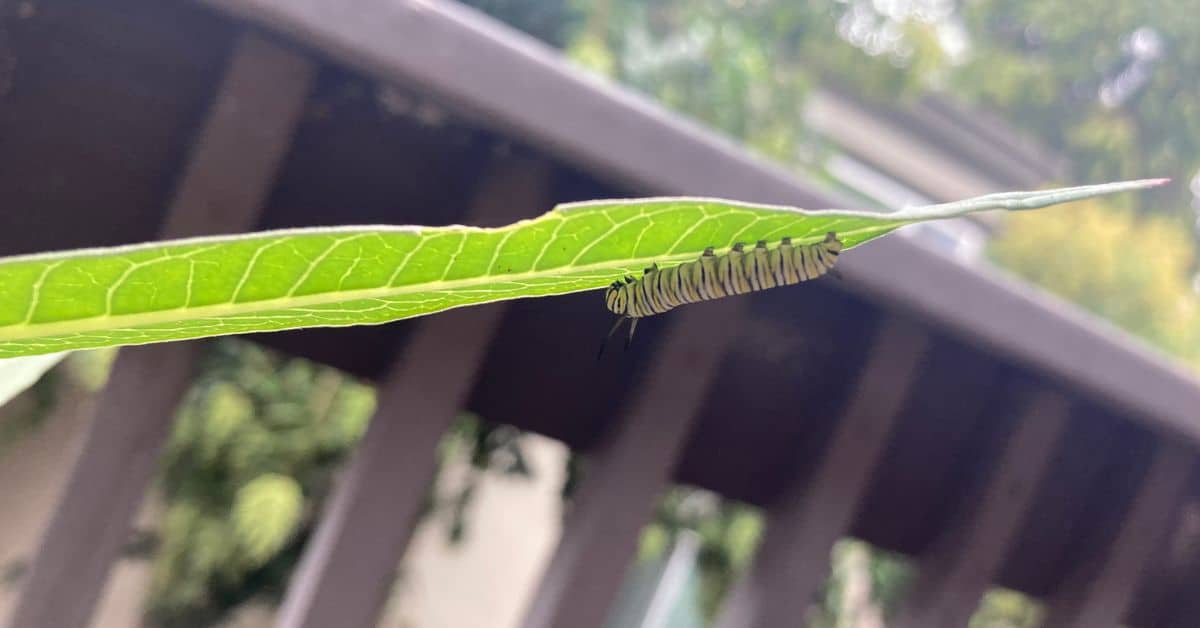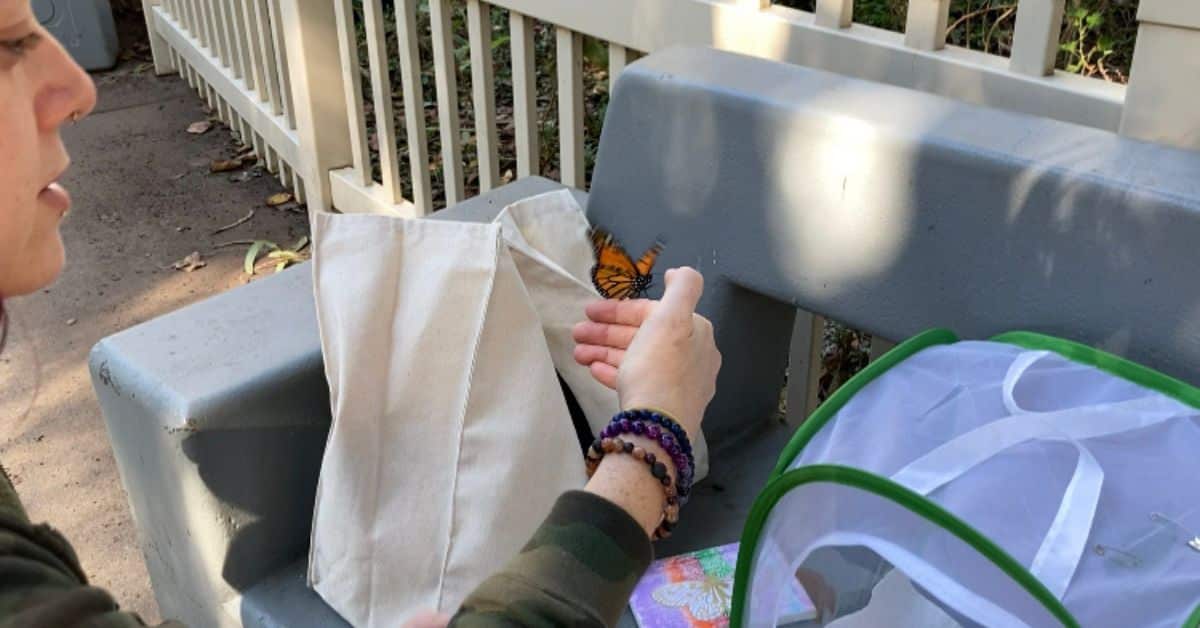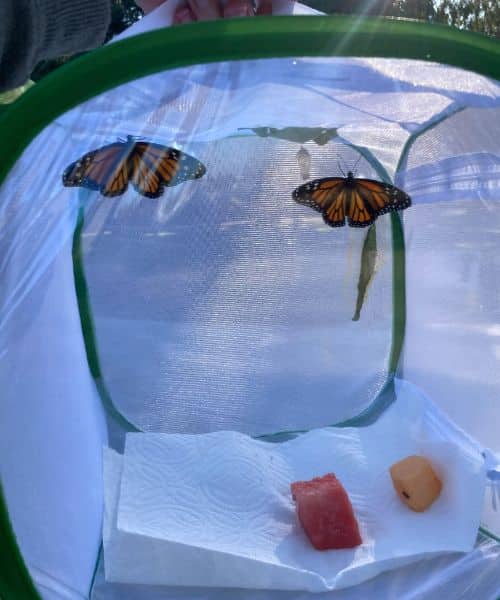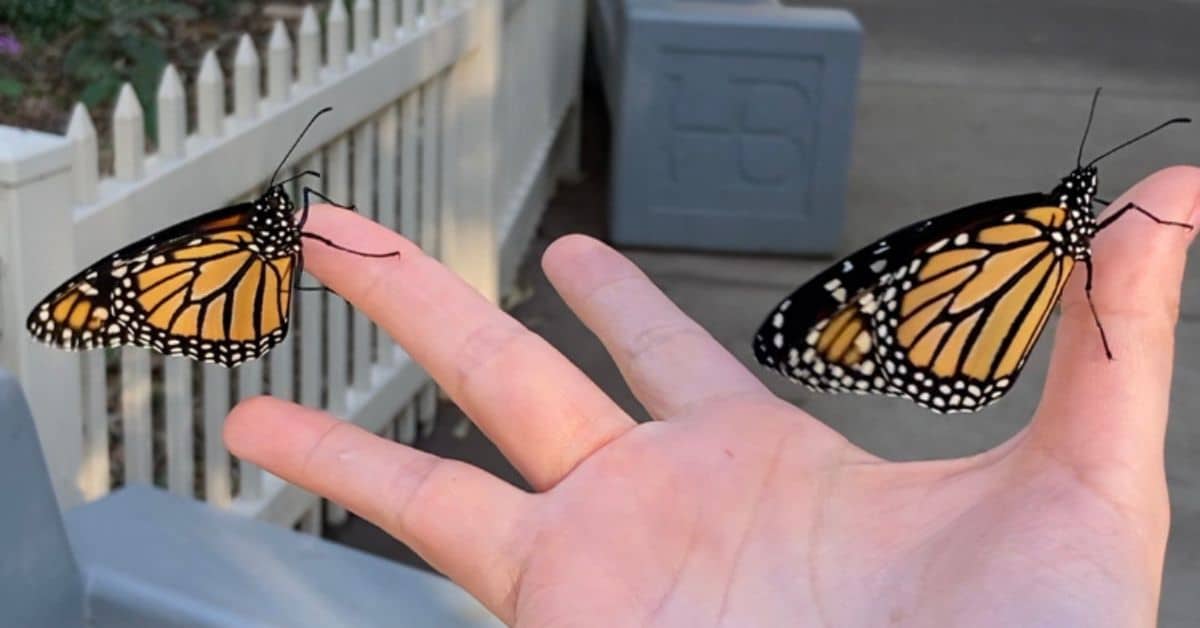This article is part of our series on psychedelics, nature connectedness, and inter-being and highlights PRATI’s purpose, reconnecting with the sacred in self, nature, community, and spirit. If you’re interested in joining us in this work, we invite you to learn more about psychedelics and nature-relatedness or join our email list to keep up to date on our offerings. If you resonate with Jennifer Walker’s story and have something you’d like to share with the PRATI community, get in touch — we’re always looking for interesting and inspiring stories to share with our community!
What would you do if you bought a milkweed plant off Facebook marketplace for your balcony, and discovered monarch caterpillars munching on the leaves? Would you think of them as an unplanned pregnancy, and buy more milkweed as they ate and ate? Would you bring their chrysalises inside when it got cold? Would you watch as they emerge and help them start their next journey?
Jennifer Walker, LMFT and PRATI alumn, would, and did. She has a deep connection with the monarch butterfly, which grew in curious and mysterious ways over the course of several months, until her personal story and that of the butterfly inextricably intertwined. Her story demonstrates the ways in which our understanding of ourselves grows in relation to the more-than-human world. As we turn our attention towards particular things, like a butterfly, the ripples of that attention influence how we see ourselves, the world around us, and our place in the web of life.
Jennifer’s story is just one example of a shift in relationship to the more-than-human world, and we’re grateful that she was willing to talk with us about her experience! We’re uplifting her story here, with hopes that you too find this inspiring, and that Jennifer’s story ripples out into the PRATI community and beyond.
The Butterfly Tattoo
If we follow a linear timeline, Jennifer’s connection with the monarch butterfly begins in a psychedelic medicine ceremony, where she connected with another participant, who happened to be a tattoo artist. Later, she learned that this artist was offering a spiritual tattoo, where a client would sit in ceremony with him and then get a tattoo based on the experience.
In Jennifer’s meditation, she saw a monarch butterfly, which ended up becoming part of the tattoo.
“That’s where it started, and at some point, a couple of months later, I wanted to buy a milkweed plant.”
The Milkweed Plant
Jennifer brought the art and symbolism of the monarch into the physical world via a milkweed plant bought off of Facebook marketplace. She knew that monarch caterpillars eat only milkweed, and she envisioned a balcony full of butterflies.
But when she brought the plant home, she discovered that the plant already had caterpillars on it, and she said,
“I kind of freaked out because I didn’t know what to do with them. It felt like an unplanned pregnancy, and I asked myself, How do I take care of them?”

She started to do research on caring for monarch caterpillars, and in her research, discovered that her milkweed plant was tropical, and not native to her hometown in California. The milkweed growing on her porch shouldn’t really be there, and while it was home to these unplanned caterpillars, the species itself is actually detrimental to the monarch butterflies as a whole. Tropical milkweed grows year-round, confusing the butterflies on their migratory path because the death of native milkweed is the sign for butterflies to move south. In fact, rather than helping the endangered Western monarch butterfly, non-native milkweeds are hastening their demise.
This research pushed Jennifer further into learning to care for the caterpillars, and she bought a “knitted thing to put the plant in so that the caterpillars wouldn’t get out and get hurt, because they were so vulnerable…and then I had to go buy more plants because they were eating so much.” Over time, as she cared for the caterpillars, she saw them getting bigger and bigger, eventually watching them create their chrysalis. As she said,
“It was wild to see it up close. I know some kids do this as a project, but this was new to me. It was just this up-close view of nature, and seeing them go from the caterpillar and suddenly they’re in the full chrysalis thing. It happens so quickly, it’s just wild.”
And Jennifer kept watching. She noticed things like small flecks inside one of the chrysalises, and then flecks developing on others, “It seems really magical, the whole experience of it.” After the monarchs were encased in their chrysalises, a storm rolled in. She immediately thought of the butterflies. She opened the door to check on them, and as she did, one of the chrysalises fell from the milkweed. She thought, what do you do with a fallen chrysalis?
After consulting Google, she determined that if she sat it down in a certain way, the butterfly could “still do their thing.” Time passed, the weather got colder, and the butterflies still hadn’t emerged. They were late bloomers. As other butterflies in California moved on toward Mexico, Jennifer’s were still in the process. She brought them inside to shelter them from the cold, and then left to attend the November PRATI training, worried that they would emerge when she was gone.
But they waited for her to come back, and not long after she returned home, the first butterfly finally emerged. She watched them shake out their wings, and she said, “They just felt like my children.” With her partner, she brought the butterflies to a local butterfly garden and released them.

Moving Forward
Jennifer’s care for and connection with the monarchs extends beyond the weeks they were on her balcony and in her home, and I asked her what that experience means for her going forward.
“I feel like the symbolism follows me a lot now. The idea of going into the chrysalis and emerging as a butterfly. I could relate to that experience, and I’m kind of getting to the point where I want to emerge now too.”
Through the experience of caring for the monarchs, Jennifer’s relationship with the butterfly changed. She said,
“Before I was like, oh yeah, butterflies are cute. And I mean, they are, but in my meditation, it was specifically a monarch butterfly that I saw. And the monarchs are very connected to Mexico because they migrate. Part of my family is from Mexico, and it feels so synchronistic that this butterfly came to me. This is somehow interconnected, and that symbolism is really important to me.”

Along with her personal connection to the monarch, Jennifer also connected with a group in her community that was working to help grow the butterfly’s numbers and help move them off the endangered species list. She connected on Facebook as she was trying to find answers to her questions about caring for her caterpillars.
While Jennifer does not want to continue to raise monarch butterflies, the experience of doing so made her consider different ways that humans can care for the more-than-human world. Knowing that “you can do a small thing to help contribute in some way, and that does feel good.” She’s looked into helping otters in Oregon, or planting trees, and is thinking about how she can incorporate nature into her therapy work with clients. She said,
“How can we, as part of therapy, grow something? Or just help people to connect in nature in that capacity? To help them have their own relationship with it in a way, and see what that feels like for them.”
She’s also expanding how she incorporates nature into her work as a therapist, and she encourages clients to consider going outside in nature or doing grounding exercises by noticing their surroundings. Sometimes, she finds it helpful to incorporate things like Oracle decks or things related to animals into conversations with clients, particularly as they are considering their intentions for a ketamine-assisted therapy journey.
Radicle Wholeness & Embodied Knowing
Psychedelic medicines help us expand consciousness to touch the ineffable—something greater than ourselves, a larger whole. While we remain unique individuals, we are also innately bound to each other and to the web of life. From this awareness, PRATI believes that psychedelic medicines enable us to access the Wholeness within us and, in doing, heal our wounds of separation by revealing our true nature. When asked how her experience with the monarch butterflies helped her connect with the sacred, whatever that meant for her, Jennifer said,
“There are the small steps that I took along the way. I don’t know why I had the idea to buy the milkweed, I really just wanted to see butterflies fly around my balcony. So it’s these sorts of things that emerge, and in relation to my spirituality, it feels that it was my intuition, or something telling me to do that, and I followed it. And it was this really special experience for me.”
She also shared how her personal experience with psychedelic medicines brought her closer to nature and gave her a sense of wholeness:
“Sometimes it feels like there’s a feminine spirit that I’m reuniting with, or just nature in general. You know, just kind of realizing that the ground is there beneath you. Or in a ceremony where I came out and the sun was shining on me and I was in the sand and I was just grasping the sand. I started crying because it was like, it’s always been here, and I’m finally seeing it and experiencing it on a deeper level.
I feel like I just didn’t know or couldn’t remember how to engage with nature. Like I was too busy in my head or worrying about this or that. It’s like I forgot those things were there, and they’re always there to hold you and be with you.”

Jennifer’s story reminds us of how the living world — both human and more-than-human — share a common energy or life force. We are not separate from nature, and psychedelic medicines can help remind us of that connection in an embodied way and allow us to experience connection and wholeness on that deeper level.
As Buddhist Zen master and poet Thich Nhat Hanh writes in The Art of Living, “Everything relies on everything else in order to manifest.” He coined the word “interbeing” to describe this deep interconnection, creating a new verb to describe the continual action of engaging with one another and with all of life. We inter-are with all life, just as Jennifer inter-was with her monarch butterflies.
What shifts in us when we sense into this unifying force or energy? What changes in our bodies when we feel a deep connection with nature? We hope that Jennifer’s story resonated with you, and that you too find ways to turn towards that life force, spirit, love, sacred, whatever you name it in your life, that abounds.
If you’d like to join us in community and engage in conversations about healing our relationship with the planet, and explore interbeing and kinship with the more-than-human world, contact us! We’re also always looking for stories like Jennifer’s, and if you’d like to share your own, let us know.
Jennifer Walker, LMFT is a psychotherapist working in Fullerton, CA at Psyche and Soma Therapy. She enjoys working with young adults and adults with a history of trauma, as well as people in the LGBTQIA+ community. Her practice includes working with clients who struggle with sexual concerns, and she utilizes a sex-positive, body-positive, trauma-informed, and identity-affirmative perspective.





